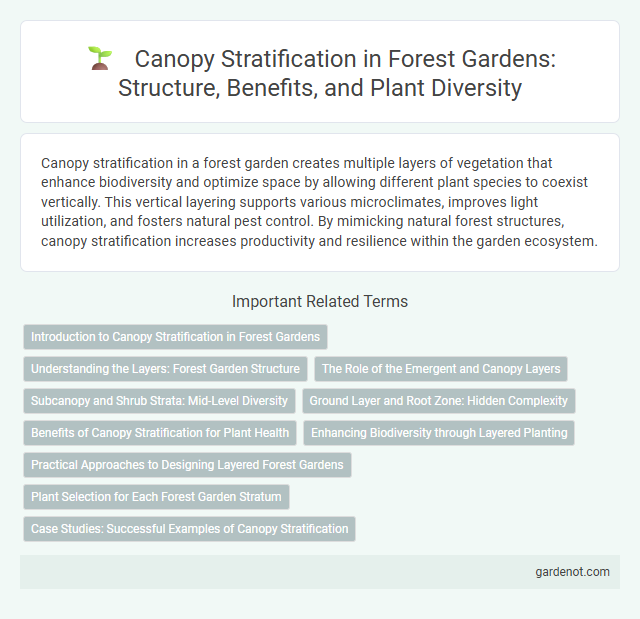Canopy stratification in a forest garden creates multiple layers of vegetation that enhance biodiversity and optimize space by allowing different plant species to coexist vertically. This vertical layering supports various microclimates, improves light utilization, and fosters natural pest control. By mimicking natural forest structures, canopy stratification increases productivity and resilience within the garden ecosystem.
Introduction to Canopy Stratification in Forest Gardens
Canopy stratification in forest gardens refers to the vertical layering of vegetation that mimics natural forest structures, enhancing biodiversity and productivity. This stratification typically includes multiple layers such as emergent trees, canopy trees, understory shrubs, herbaceous plants, and ground cover. Designing forest gardens with distinct canopy layers optimizes sunlight capture and resource allocation, promoting a resilient and sustainable ecosystem.
Understanding the Layers: Forest Garden Structure
Forest garden canopy stratification involves multiple vertical layers, including the tall emergent trees, mid-story trees, shrubs, herbaceous plants, ground covers, and root crops, each fulfilling distinct ecological roles. This layered structure maximizes sunlight capture, improves biodiversity, and enhances nutrient cycling by mimicking natural forest ecosystems. Understanding these layers enables sustainable design and optimizes plant interactions for higher productivity and resilience.
The Role of the Emergent and Canopy Layers
The emergent and canopy layers play a crucial role in forest garden ecosystems by capturing the majority of sunlight and creating microclimates that support diverse understorey plants. These upper layers also provide essential habitats for pollinators and birds, enhancing biodiversity and natural pest control. Their structural complexity improves air circulation and water retention, promoting overall forest garden resilience and productivity.
Subcanopy and Shrub Strata: Mid-Level Diversity
Subcanopy and shrub strata play a critical role in forest garden canopy stratification by providing mid-level diversity that supports ecological stability and increased yield. These layers host a variety of fruiting trees, nitrogen-fixing shrubs, and medicinal plants that enhance nutrient cycling and habitat complexity. Integrating subcanopy and shrub species such as hazelnut, serviceberry, and elderberry optimizes vertical space and promotes resilience against pests and environmental stress.
Ground Layer and Root Zone: Hidden Complexity
The ground layer in a forest garden consists of low-growing plants, mosses, and leaf litter that maintain soil moisture and provide habitat for beneficial insects and microorganisms. The root zone beneath supports a complex network of roots interacting with mycorrhizal fungi, enhancing nutrient uptake and improving soil structure. This hidden complexity in the ground layer and root zone sustains biodiversity and promotes resilience within the forest garden ecosystem.
Benefits of Canopy Stratification for Plant Health
Canopy stratification in forest gardens enhances plant health by creating multiple layers of vegetation that optimize sunlight exposure and air circulation. This vertical diversity reduces competition for resources, promotes biodiversity, and supports beneficial microclimates that protect plants from pests and diseases. Improved canopy structure also aids in moisture retention and soil preservation, fostering resilient and thriving plant communities.
Enhancing Biodiversity through Layered Planting
Canopy stratification in forest gardens creates multiple layers of vegetation, from tall trees to ground cover, which enhances biodiversity by providing diverse habitats for various species. This layered planting promotes ecological stability, supports pollinators and wildlife, and optimizes resource use like sunlight, water, and nutrients across different vertical zones. By mimicking natural forest structures, canopy stratification fosters a resilient and productive ecosystem beneficial for both plants and animals.
Practical Approaches to Designing Layered Forest Gardens
Canopy stratification in forest gardens involves organizing plant species into multiple vertical layers to maximize space and resource use. Practical approaches include selecting diverse trees, shrubs, and groundcovers that occupy distinct canopy levels, enhancing light penetration and biodiversity. Designing with species suited for upper canopy, understory, shrub, herbaceous, and root layers creates a resilient, productive ecosystem that mimics natural forests.
Plant Selection for Each Forest Garden Stratum
Careful plant selection for each forest garden stratum enhances biodiversity and productivity by mimicking natural forest layers. Tall canopy trees such as oak or walnut provide shade and structure, while the understory consists of smaller trees like hazelnut and serviceberry adapted to partial sunlight. Shrubs, herbs, and groundcovers fill lower layers with species like currants, comfrey, and wild ginger, contributing to nutrient cycling and habitat diversity.
Case Studies: Successful Examples of Canopy Stratification
Successful examples of canopy stratification in forest gardens demonstrate multi-layered vegetation, mimicking natural forests with trees, shrubs, herbs, and ground cover. The tropical forest garden in Suriname showcases diverse fruit and timber species, enhancing biodiversity and productivity through vertical space utilization. Similarly, the temperate agroforest in Europe integrates nut trees, berry bushes, and herbaceous plants, resulting in improved soil health and sustainable yields.
Canopy stratification Infographic

 gardenot.com
gardenot.com